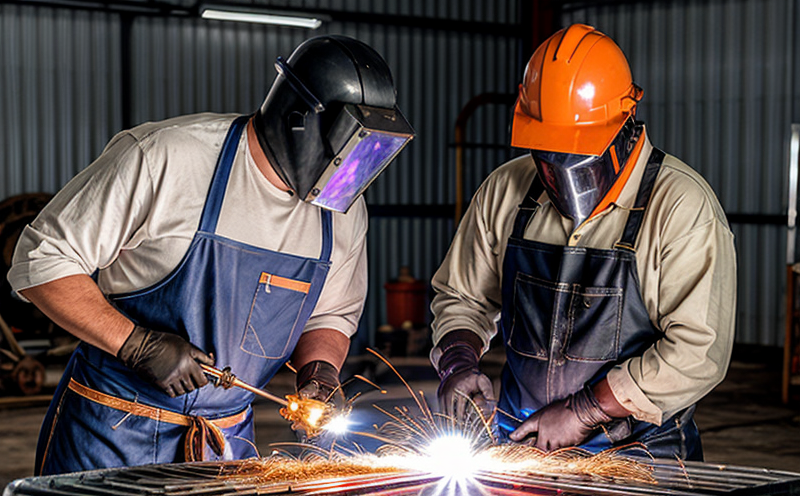Welding apron inspection
The inspection of welding aprons is a critical task within Personal Protective Equipment (PPE) management. Welding aprons are designed to protect workers from heat, sparks, and flying debris, thereby minimizing the risk of burns and other injuries during welding operations. Ensuring that these aprons meet strict safety standards is essential for both worker safety and compliance with regulatory requirements.
The inspection process involves several key steps aimed at ensuring the quality and reliability of the apron. These steps include visual examination, dimensional checks, fabric integrity tests, and performance testing under simulated welding conditions. Visual inspections are conducted to identify any visible defects such as tears, holes, or signs of wear that could compromise the protective function.
Dimensional checks ensure that the apron adheres to specified size tolerances, which is crucial for proper fit and comfort during use. Fabric integrity tests assess the durability and strength of the materials used in constructing the aprons. These tests may involve soaking the fabric samples in water or exposing them to heat cycles to simulate real-world conditions.
Performance testing under simulated welding conditions involves subjecting the apron to controlled environments where high temperatures and radiant heat are applied. This helps determine how well the apron can withstand these conditions without failing, ensuring that it remains effective throughout its intended use. Compliance with relevant standards such as ISO 6531-2 for flame-resistant textiles is essential to ensure that the aprons meet the necessary safety and performance criteria.
The inspection process also includes ensuring that all labeling and certification information on the apron are accurate and comply with applicable regulations. This includes checking that the apron has been properly rated for the types of hazards it is intended to protect against, such as radiant heat levels or flame resistance ratings.
By adhering strictly to these inspection protocols, laboratories can provide welding aprons that are not only reliable but also meet all necessary safety standards. This comprehensive approach ensures worker protection and regulatory compliance, contributing significantly to a safer working environment for all personnel involved in welding activities.
Applied Standards
The inspection of welding aprons must strictly adhere to several international standards that outline the criteria for flame-resistant materials used in PPE. The primary standard governing this inspection is ISO 6531-2, which specifies requirements for flame-resistant textiles intended for use in protective clothing, including welding aprons.
In addition to ISO standards, other relevant international guidelines such as ASTM F1891 and EN 469:2012 provide additional recommendations on the design and performance of PPE. ASTM F1891 focuses specifically on flame-resistant garments used in industrial settings like welding, while EN 469 covers protection against heat and flames.
These standards not only define minimum performance levels but also outline rigorous testing procedures to ensure that each product meets these stringent requirements before being approved for use. By adhering strictly to these guidelines, laboratories can provide assurance that the inspected aprons meet all necessary safety and performance criteria, thereby enhancing worker protection and compliance with regulatory requirements.
Compliance with these standards ensures not only that the aprons perform effectively under various conditions but also that they are labeled correctly according to their intended use. Proper labeling is critical as it informs users about the limitations of the apron regarding specific hazards like radiant heat levels or flame resistance ratings. This information enables workers and supervisors to make informed decisions about when and where certain types of PPE should be used, further enhancing overall safety.
Quality and Reliability Assurance
- Visual Inspection: Ensures that there are no visible defects such as tears or holes in the fabric. This step checks for signs of wear and tear that could compromise the protective function of the apron.
- Dimensional Checks: Verifies that the apron meets specified size tolerances, ensuring proper fit and comfort during use.
- Fabric Integrity Tests: Evaluates the durability and strength of the materials used in constructing the aprons. These tests may involve exposing fabric samples to water or heat cycles to simulate real-world conditions.
- Performance Testing: Submits the apron to controlled environments where high temperatures and radiant heat are applied, determining how well it can withstand these conditions without failing.
The combination of these tests ensures that welding aprons not only meet but exceed the safety and performance standards set forth by international regulations. Through rigorous testing and adherence to applicable guidelines, laboratories maintain a high level of quality control, which directly translates into greater reliability and trust in their products among users.
Competitive Advantage and Market Impact
The inspection of welding aprons offers significant competitive advantages for companies operating within the PPE sector. By providing thoroughly inspected and certified aprons, organizations can demonstrate a commitment to worker safety and regulatory compliance. This proactive approach enhances brand reputation and builds customer confidence, which are vital factors in today’s highly competitive market.
Compliance with strict international standards such as ISO 6531-2 ensures that the inspected aprons meet all necessary safety and performance criteria. This not only meets but often exceeds regulatory requirements, positioning the company as a leader in quality assurance within the industry.
The inspection process also helps identify potential issues early on, allowing for swift corrective actions before products reach end-users. Such proactive measures demonstrate an ongoing commitment to excellence and continuous improvement, further strengthening market position. Moreover, by ensuring that aprons perform effectively under various conditions, companies can enhance worker safety across all operational environments.
Furthermore, the inspection process ensures accurate labeling of the aprons according to their intended use, providing crucial information about hazards such as radiant heat levels or flame resistance ratings. This transparency fosters better decision-making by users and supervisors, ultimately contributing to safer working practices throughout the industry.





